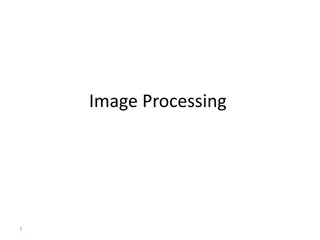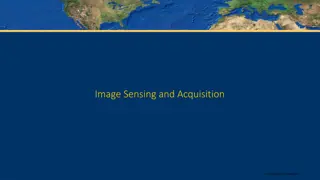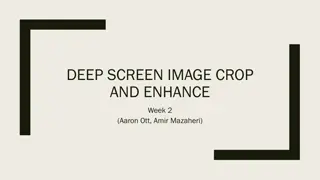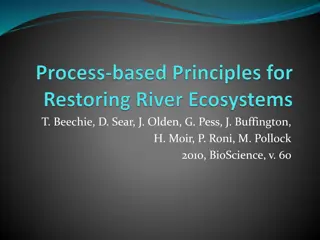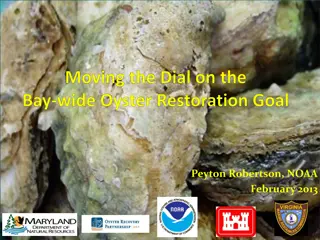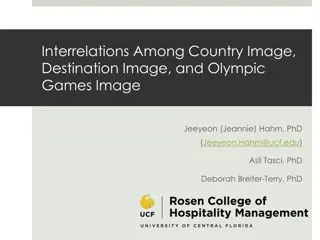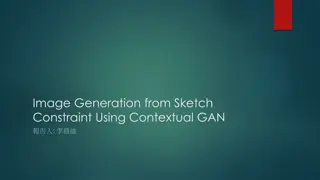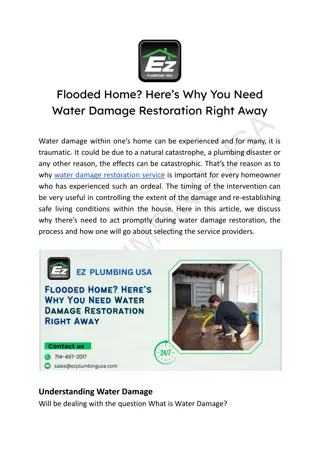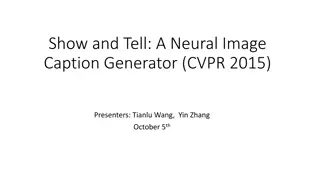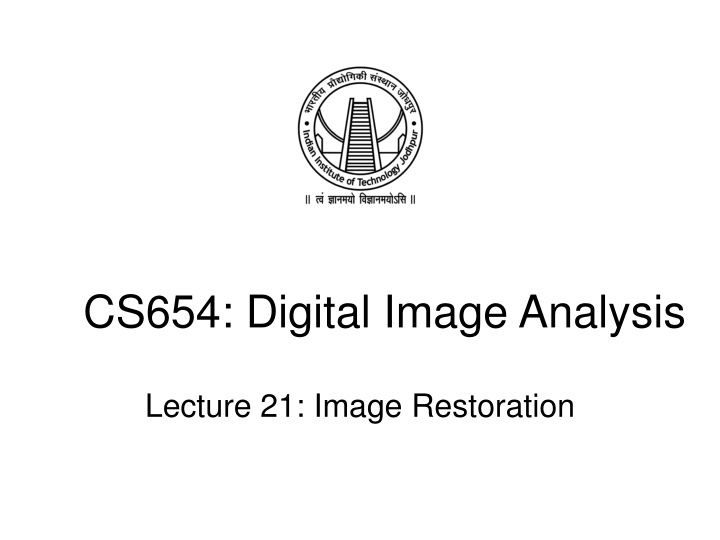
Image Restoration in Digital Image Analysis
Explore the concepts of image restoration, including its definition, model, and techniques for minimizing known degradations in images. Learn about the differences between restoration and enhancement, common causes of image degradation, and key assumptions in linear position invariant degradation. Dive into image formation in the continuous domain and the impulse response of the system.
Download Presentation

Please find below an Image/Link to download the presentation.
The content on the website is provided AS IS for your information and personal use only. It may not be sold, licensed, or shared on other websites without obtaining consent from the author. If you encounter any issues during the download, it is possible that the publisher has removed the file from their server.
You are allowed to download the files provided on this website for personal or commercial use, subject to the condition that they are used lawfully. All files are the property of their respective owners.
The content on the website is provided AS IS for your information and personal use only. It may not be sold, licensed, or shared on other websites without obtaining consent from the author.
E N D
Presentation Transcript
CS654: Digital Image Analysis Lecture 21: Image Restoration
Recap of Phase 1 Image: acquisition, digitization Geometric Transformations: Interpolation techniques Image Transforms (spatial to frequency domain) Image Enhancement (spatial and frequency domain)
Outline of Lecture 21 Image restoration vs. enhancement What is restoration Image restoration model Continuous, discrete formulation Point spread function Noise
Image restoration It refers to the minimization or removal of the known degradations in an image. De-blurring, noise filtering, correction of geometric distortion etc. Original image Blurred input image Restored image
Restoration vs. Enhancement E N H A N C E M E N T R E S T O R A T I O N
Causes of Common degradation Sensor noise (poor illumination, long exposer) Improper focusing (out of focus image) Geometric restoration Lense Irregular movement of the sensor Atmospheric turbulence
Assumptions Degradation function must be a linear system The system is homogeneous The system is shift invariant
Linear position invariant degradation ? ?,? = ? ? ?,? + ?(?,?) Assume ? ?,? = 0 ? ?,? = ? ? ?,? ? is a Linear system ? ??1?,? + ??2(?,?) = ??[?1?,? ] + ??[?2?,? ] If ? = ? = 1; Additivity property If ?2(?,?) = 0; Homogeneity property ? is a Position Invariant ? ?(? ?,? ?) = ? ? ?,? ? ]
Image formation in continuous domain ? ?,? = ? ?,? ? ? ?,? ? ???? ? ?,? = ?[? ?,? ] = ? ? ?,? ? ? ?,? ? ???? Additivity property ? ?,? = ? ? ?,? ? ? ?,? ? ???? Homogeneity property ? ?,? = ? ?,? ? ? ? ?,? ? ???? Impulse response of H ? ?,?,?,? = ? ? ? ?,? ?
Image formation in continuous domain ? ?,? = ? ?,? ? ? ? ?,? ? ???? ? ?,? = ? ?,? ? ?,?,?,? ???? A linear system is characterized by its impulse response ? ?,? ? ? ?,? ? ???? Position Invariant ? ?,? =
Point Spread Function Optical System scene image Ideally, the optical system should be a Dirac delta function. However, optical systems are never ideal. ( ) x ( ) x Optical System PSF point source point spread function Point spread function of Human Eyes
PSF A Point source ? ?,?,?,? ?1(?1,?1) ?2(?2,?2)
Point Spread Function hyperopia myopia normal vision Astigmatism Images by Richmond Eye Associates
Discrete formulation ? 1 1-D case: ? ? = ? ? ? ? ;0 ? ? 1 ?=0 Matrix notation: ?(0) ?(? 1) ?(0) ?(? 1) (0) ( ? + 1) (0) = (? 1) ? ? ?
Circulant Matrix Assume ? to be periodic, with periodicity ? 0 1 ? 1 0 (? 2) ? 2 (? 1) (? 3) 1 (2) (0) ? = (? 1) Each row vector is rotated one element to the right relative to the preceding row vector
Extension to 2-D ? 1 ? 1 ? ?,? = ? ?,? (? ?,? ?) ?=0 ?=0 ? ?,? and (?,?) are of dimension ? ? Matrix notation: ? = ?? + ? ?: Vector of dimension ?? ?: Vector of dimension ?? ?:Matrix of dimension ?? ??
A model restoration process ? ?,? ?(?,?) ?(?,?) ?(?,?) ?(?,?) + ? ?,? = ?(?,?) ?(?,?) Target
Noise models Statistical behavior of the grey-level values Can be modeled as a random variable with a specific PDF Gaussian noise Rayleigh noise Gamma noise Exponential noise Uniform noise Impulse (salt & pepper) noise
Gaussian noise The PDF of a Gaussian noise is given by p(z) 1 22 / 2 = ( ) z ( ) p z e 2 2 z +
Rayleigh noise The PDF of a Rayleigh noise is given by 2 ( ) / z a b p(z) ( ) z a e for z a 2 = ( ) p z b 0 for z a The mean and variance are given 4 ( ) =b 2 = + and / 4 a b 4 a z Application areas: MRI images, Underwater images a+ b 2
Gamma noise The PDF of a Gamma noise is given by p(z) 1 b ( ) 1 a b ) 1 = ( b K e 1 b b a z ( 1 )! b K az 0 e for z = ( ) p z ( 1 )! b 0 0 for z The mean and variance are given b b = = 2 and 2 a a z b 1 a
Exponential noise The PDF of a Exponential noise is given by p(z) az 0 ae for z a = ( ) p z 0 0 for z The mean and variance are given 1 a 1 and = 2 = 2 a z Note: It is a special case of Gamma PDF, with b=1.
Uniform noise The PDF of a Uniform noise is given by p(z) 1 if a z b = ( ) p z 0 b a 1 otherwise b a All noise is present within this interval The mean and variance are given b 2 ( ) a a+ b = 2 = and 12 2 z a b
Application of Uniform noise b a Quantization Predictive coding
Impulse (salt-and-pepper) noise The PDF of a (bipolar) impulse noise is given by p(z) = P for z a a = = ( ) p z P 0 for z b b bP otherwise aP z a b
Thank you Next Lecture: Image Restoration








